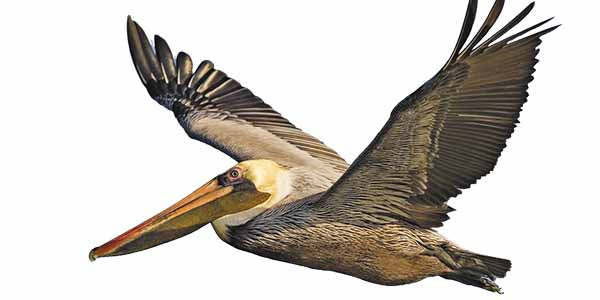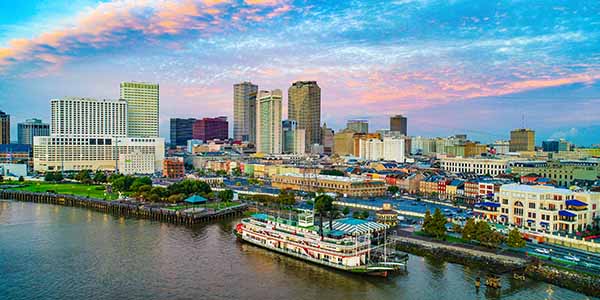Welcome to Louisiana
Sitting on the Gulf Coast just east of Texas, Louisiana’s landscapes consist largely of Mississippi Delta marshlands, dense forests and the boggy bayous. Against this backdrop, local towns pulse with exotic dialects, spicy cuisines and the cultural signatures of its French, Spanish, Creole and Cajun settlers. Whether you stroll the streets of densely populated New Orleans or take an airboat into a bayou, you’re never far from the down-home cooking and welcoming warmth of Pelican State locals.

State Bird: Eastern Brown Pelican. US National Park Service
Great Times in the Big Easy
Known for its haunting history, romantic architecture and radiant culture, New Orleans is one of the nation’s most evocative cities. A visit to the so-called Big Easy is not complete without taking in the tunes at a storied jazz bar or sampling the spicy jambalaya. The Big Easy’s raucous atmosphere thrives in the French Quarter and on Bourbon Street, while the nearby Jean Lafitte National Historical Park and Preserve serves up a tranquil atmosphere for exploration of the region’s landscapes and history. Centrally located, the capital city of Baton Rouge offers up a saucy mix of cultures, as well, with Creole and Cajun influences found in the food and entertainment.
Pelican State Adventure
While in eastern Louisiana, look to the skies for migratory birds streaming along the Mississippi Flyway. Grab your binoculars and head to one of the 30 areas along the Mississippi River Birding Trail. The Mississippi Flyway is not only a top spot for birding, it’s also a waterfowl-hunting haven. The Pass-a-Loutre Wildlife Management Area promises thrilling hunting action at the mouth of the Mississippi River.
Wild Waterways
Louisiana’s story has been shaped by its waterways, from the Mississippi River, which runs along the eastern border, to the Gulf of Mexico along the southern coast. Rich swamplands, marshes and bayous create distinct habitats to explore on zippy airboat tours or meandering kayaking trips. Watch alligators emerge from coffee-colored waters. The Barataria Preserve and Palmetto Island State Park are just two of the many places to experience Louisiana’s unique landscapes. For a beach retreat, head to Grand Isle State Park, located on a barrier island off the southern coast. Watch pelicans and seagulls skirt the surf, and relax to the sound of waves hitting the shore.

Getty Images
Paddling and Fishing Fun
Louisiana’s distinctive waterways are perfect for paddlers who want to explore swamps and bayous. The Bayou Bartholomew and Lake Martin both feature massive, moss-filled cypress trees rising from the inky waters, making them popular spots. For a unique fishing excursion in similar landscapes, head to Caddo Lake, located on the Louisiana-Texas border. Toledo Bend Reservoir, also on the Louisiana-Texas border, consistently offers up quality bass fishing, having been named the best bass lake in the nation two years in a row. The Red River in the northeast is a favorite of anglers, known for its big catfish and bass, while the coastal waters in the south are the places to go for redfish and snapper, staples in Louisianan cuisine. The huge Atchafalaya Basin, west of Baton Rouge, is a paradise for adventurous anglers and paddlers.
Party Down in N’awlins and Beyond
New Orleans may seem synonymous with Mardi Gras, but it’s not the only place that hosts pre-Lent carnival celebrations in the state. Lafayette, Baton Rouge and Lake Charles are just a few of the towns that go all out for this blowout. New Orleans is the granddaddy of them all, of course. Expect to find rollicking parades, colorful costumes and sweet king cakes making up an epic party. Louisiana is known for the rich mix of cultures that bring spice to the state, and Lafayette celebrates these cultures and more with the Festival International de Louisiane. Held each April, this five-day event is the nation’s largest international music and arts festival.
Imprints of the Past
Built over 3,400 years ago, the earthwork mound at Poverty Point World Heritage Site is a mystery left by some of Louisiana’s earliest peoples. Take a tour and visit the museum to imagine what life was like then. Centuries later, Louisiana would see its first European settlers with the first permanent settlement in what is now the town of Natchitoches. Established in 1714, this historic town is a centerpiece of the Cane River National Heritage Area, which tells the story of the French, Spanish and Creole cultures that shaped Louisiana. Exiled Canadian Acadians added to the cultural mix when they arrived in 1755 and settled along the southern coast. Later known as the Cajuns, these settlers brought a joie de vivre to the music and cuisine of the coast.



